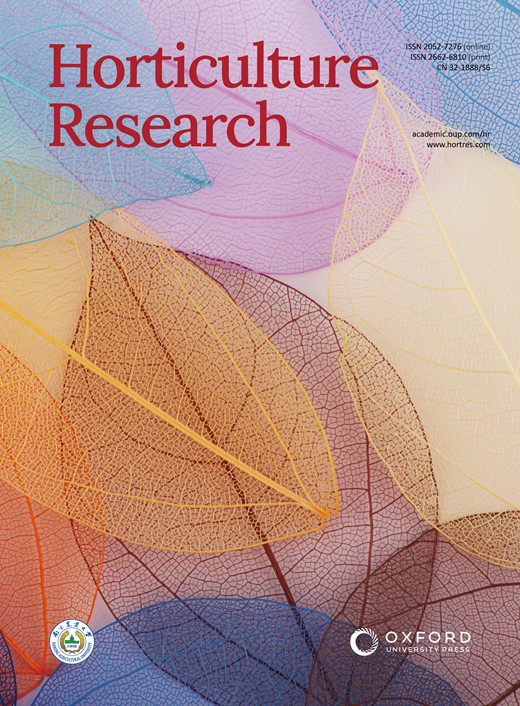Evolutionary dynamics and functional divergence of the UGT gene family revealed by a pangenome-wide analysis in tomato
IF 8.5
1区 农林科学
Q1 Agricultural and Biological Sciences
引用次数: 0
Abstract
UDP-dependent glycosyltransferases (UGTs) play a critical role in producing glycosylated metabolites that mediate plant-environment interactions. Recent studies have examined the role of UGT genes across various plant genomes. However, the evolutionary history and functional divergence of the UGT pan-gene family in the genus Solanum have not yet been explored. This study integrated data from 61 tomatoes and 9 representative genomes, ranging from algae to angiosperms, to identify 12,073 genes. Phylogenetic analysis trajectory the UGT gene family from unicellular algae through ferns, mosses, gymnosperms, and ultimately to angiosperms. The study identified a significant number of tomato-specific UGT genes and explored the expansions of UGT73 and UGT85 subfamilies. The entire UGT genes (10,769) in tomato were classified into 118 orthologous gene groups, including 58 core, 31 softcore, 10 dispensable, 19 private orthologous gene groups, and core groups contained 7,811 genes, representing 72.53% of total UGT genes. Analysis of gene family expansion revealed that whole-genome triplication and tandem duplication events play significant roles in the expansion of the UGT gene family. Selection pressure analysis revealed that the UGT genes experienced purifying selection in the genus Solanum. Additionally, expression profiles of some UGT genes in different tissues demonstrated expression divergence of multicopy genes across different UGT subfamilies due to the increase of gene dosage. Subcellular localization prediction revealed that most genes are localized in the chloroplast. These findings provide critical insights into the evolution and function of the UGT genes in tomato, laying a foundation for further exploration in adaptive evolution.基于全基因组分析的番茄UGT基因家族进化动态与功能分化
udp依赖性糖基转移酶(UGTs)在产生糖基化代谢物介导植物与环境相互作用中起关键作用。最近的研究已经检查了UGT基因在各种植物基因组中的作用。然而,UGT泛基因家族在茄属植物中的进化历史和功能分化尚未深入研究。这项研究整合了61种番茄和9个代表性基因组的数据,从藻类到被子植物,共鉴定出12073个基因。UGT基因家族从单细胞藻类到蕨类、苔藓、裸子植物,最终到被子植物的系统发育分析轨迹。该研究发现了大量的番茄特异性UGT基因,并探索了UGT73和UGT85亚家族的扩增。番茄UGT基因共10769个,共分为118个同源基因群,其中核心同源基因群58个,软核同源基因群31个,非必需同源基因群10个,私有同源基因群19个,核心同源基因群共7811个,占UGT基因总数的72.53%。基因家族扩展分析表明,全基因组三复制和串联复制事件在UGT基因家族的扩展中发挥了重要作用。选择压力分析表明,UGT基因在茄属植物中经历了纯化选择。此外,一些UGT基因在不同组织中的表达谱显示,由于基因剂量的增加,不同UGT亚家族的多拷贝基因表达出现了差异。亚细胞定位预测表明,大多数基因定位在叶绿体中。这些发现为了解番茄UGT基因的进化和功能提供了重要的见解,为进一步探索适应进化奠定了基础。
本文章由计算机程序翻译,如有差异,请以英文原文为准。
求助全文
约1分钟内获得全文
求助全文
来源期刊

Horticulture Research
Biochemistry, Genetics and Molecular Biology-Biochemistry
CiteScore
11.20
自引率
6.90%
发文量
367
审稿时长
20 weeks
期刊介绍:
Horticulture Research, an open access journal affiliated with Nanjing Agricultural University, has achieved the prestigious ranking of number one in the Horticulture category of the Journal Citation Reports ™ from Clarivate, 2022. As a leading publication in the field, the journal is dedicated to disseminating original research articles, comprehensive reviews, insightful perspectives, thought-provoking comments, and valuable correspondence articles and letters to the editor. Its scope encompasses all vital aspects of horticultural plants and disciplines, such as biotechnology, breeding, cellular and molecular biology, evolution, genetics, inter-species interactions, physiology, and the origination and domestication of crops.
 求助内容:
求助内容: 应助结果提醒方式:
应助结果提醒方式:


